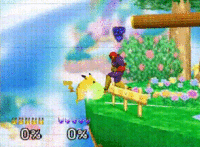Stalling
Stalling is any deliberate attempt to avoid conflict and waste time, with the goal of making the game unplayable or winning a match by going to time out. It involves using actions and techniques to waste time, such as running away, planking, and infinites. Stalling is not to be confused with camping. A camping opponent still intends to fight, just at a distance; a stalling opponent does not intend to fight in any way.
Examples of stalling[edit]
Super Smash Bros.[edit]
- Abusing the invincibility frames of Pikachu's Quick Attack move while repeatedly planking the edge to render the opponent unable to damage Pikachu.
- Using the Luigi ladder with two Luigis to stall under or above the stage.[1]
Super Smash Bros. Melee[edit]
- Using Peach's Peach Bomber repeatedly against a wall without gaining height. This technique is banned in tournaments if used just to waste time in a match, although it is allowed for recovering.
- Using Jigglypuff's Rising Pound repeatedly away from the other player offstage. As with Peach Bomber wall stalling, this technique is banned if used to waste time, though it is allowed for recovery.
- Luring the opponent to the edge of the stage, then planking while using Jigglypuff's Sing to constantly put the opponent to sleep, depriving them of any sort of movement. This technique is banned in tournaments.
- Using the Luigi ladder with two Luigis to rise a potentially extremely high vertical distance (as the Luigis will not be Star KO'd even if surpassing the upper blast line while using this technique). This technique is banned in doubles play.
- All fighters can infinitely ledgestall, however the ledgegrab limit prevents this.
Super Smash Bros. Brawl[edit]
- Repeatedly using Homing Attack with Sonic or Kirby under a stage to repeatedly rebound off of the bottom of the stage and stay in place. This technique is banned.
- Using Meta Knight's Infinite Dimensional Cape so that he cannot be attacked. This technique is banned.
- Gliding under the stage to the other side. Meta Knight is particularly adept at this since he can glide twice without landing. This is known as "scrooging" and is usually banned.
Super Smash Bros. 4[edit]
- Using the Pac-Ladder with two Pac-Mans to repeatedly bounce off each other's trampoline for potentially extremely high vertical distance (as the Pac-Mans will not be KO'd even if passing the upper blast line while using this technique). This technique is banned in doubles play.
Super Smash Bros. Ultimate[edit]
- Eliminating an opposing teammate, then alternating between Ridley's Skewer and Jigglypuff's Sing to lock the remaining opponent in place. This used to work with King K. Rool's down throw instead of Sing, but an update patched this so that Skewer could not affect opponents with Grab invincibility.
- Lucario can plank with Extreme Speed, even after the 6 grab limit has been passed. However, Lucario will not get any intangibility from successive ledge grabs.
- Sonic is infamous for being able to stall with his incredible speed.
- Using a combination of projectile, air, and circle camping, Isabelle can stall select characters with poor run and air speed on specific stages.
- Steve has a specific planking technique of putting a block under the ledge to mine and stall on the block. For the opponent its extremely difficult and risky to approach Steve standing under the ledge.
In competitive play[edit]
Stalling is generally considered a viable strategy for certain matchups, as getting a quick lead early on and then avoiding the opponent until time runs out is considered easier than actually engaging and attempting to take stocks. Agile characters, especially ones with good air mobility that can safely travel under a stage, are usually the most successful at stalling. That being said, stalling goes against the fighting game philosophy of the Smash series, and therefore is generally looked down upon at a serious competitive level. Not only do most players find stalling annoying to deal with, most spectators find stalling boring to watching, leading to an uncomfortable situation for everyone.
Many forms of stalling are typically banned in tournaments in addition to techniques that may lead to stalling. Excessive stalling can prolong a tournament and will often have the smasher disqualified. However, this rule is sometimes difficult to enforce, as "excessive stalling" is a subjective phrase with many opinions on where the threshold is. The act of punishing stalling at all has even proven controversial, as some consider stalling to be exploitive of character mobility and detracting, while others see it as a skillful and legitimate way to win, requiring careful spacing and effective mindgames. Some forms of stalling are allowed if the opponent is capable of dealing with them or if the technique is too subtle to be recognized as stalling. Other forms of stalling are allowed a maximum amount of executions, such as a rule in many Melee majors where a maximum of 60 planking attempts are allowed. However, this rule only comes into effect in the game goes to a time out, meaning players theoretically can perform the technique an unlimited amount of times as long as the they can take all of their opponent's stocks.
